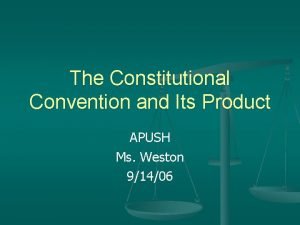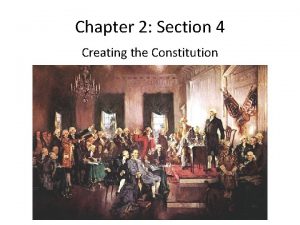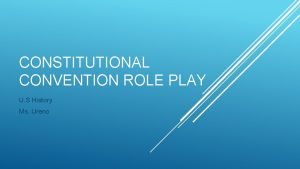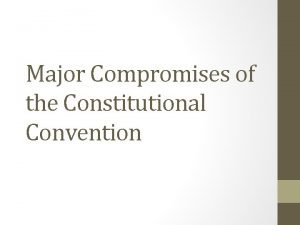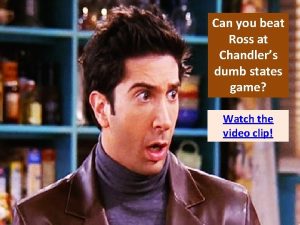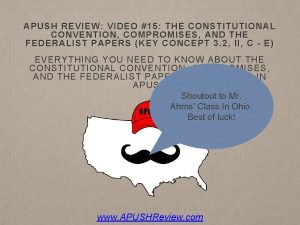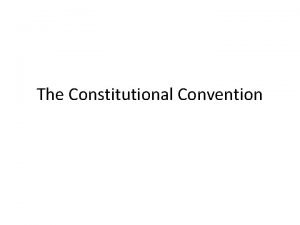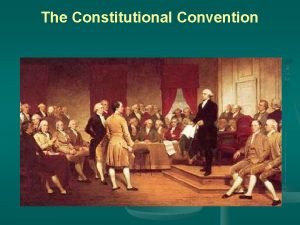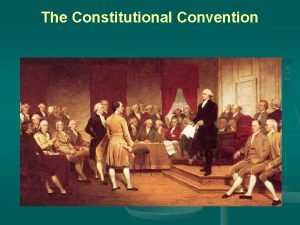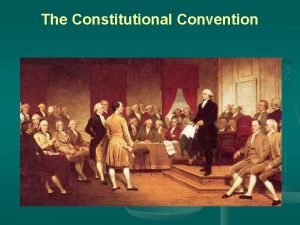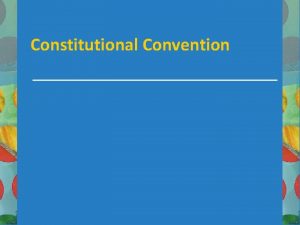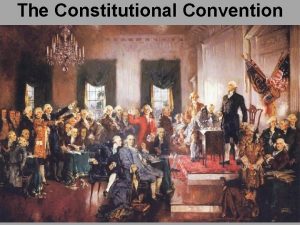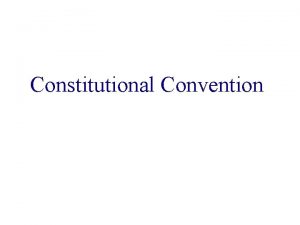After Independence pt 2 The Constitutional Convention the









- Slides: 9

After Independence (pt. 2) The Constitutional Convention, the Constitution, the Bill of Rights

The Great Compromise • The Great Compromise is a result of a “compromise” between two views about how to structure the new American Government • The Virginia Plan (proposed by Madison) • Divided power between three branches: executive, legislative, and judicial • Strong executive; seven years in office; appoint all executive and judicial members with approval of Congress • Allow Congress to tax and regulate commerce; also veto state laws • Bicameral legislature • Representation based on population; favored big states like VA and Mass. • The New Jersey Plan (proposed by William Patterson of NJ) • • Congress could tax and regulate commerce Unicameral legislature with each state one vote Limit powers of the central government Few changes to composition of the Art. Of Confed. and the confederatoion

The Great Compromise • Proposed by Sherman of Connecticut; also known as the Connecticut Compromise • Blended the Virginia and New Jersey Planr • Legislature: • Senate = two reps per state, every vote was equal • HOR = based on population (granting more power to the more populated states) • Executive: a powerful president • A judicial branch • The Great compromise led to federalism. Federalism = where government is divided between federal and state governments • States and federal government shared some rights • They also had exclusive rights—their own rights

The Three-Fifths Compromise • The southern states were worried about the future of slavery • They did not want Congress to abolish slavery • Northerners did not want southern states to have an unfair advantage in Congress • The Three-Fifths Compromise dealt with the issue of slaves adding to a states population which, in turn, would give those states more power • Slaves would count as 3/5 of a person to be added to the states free population gave more seats in Congress to the southern states • It also forbade Congress from blocking the importation of slaves • Furthermore, fugitive slaves had to be returned to their owners; running away to a free state did not make you free

Ratification • Although their initial goal had been to modify or amend the Articles of Confederation, the delegates had succeeded in drafting an entirely new constitution—The Constitution • Compromises had been made and a new form of government had been created, the only thing left to do was to officially approve (ratify) the new Constitution • However, problems will arise when 3 of the 42 delegates present opted not to sign • Immediately, the delegates knew that they would not be able to obtain official approval from all 13 states so they decided to arbitrarily change the rules • Approval from 9 states would suffice • State legislatures would not vote on it, instead specially elected conventions would determine a state’s choice for or against the Constitution

Issues with Ratification • Two groups emerged: the Federalist, that favored ratification; and the Antifederalist, who opposed ratification • Federalists included G. Washington, Madison, and Alexander Hamilton • They stressed the weaknesses of the Articles • A strong central government • Antifederalists include Samuel Adams, Patrick Henry, and John Hancock • Believed that the Constitution was a “retreat from the liberty won by the Revolution” • A weak federal/ central government • Wanted to maintain states’ rights • Furthermore, public support for the new Constitution was low • Most citizens were farmers who depended on debt-relief laws that would be abolished under the new Constitution; however, they GW and Ben Franklin garnered a lot of support once they

Federalists v. Antifederalists • Support for the Federalists and the Constitution began to increase • GW and Ben Franklin • Merchants and artisans began supporting in hopes the Constitution would provision economic relief by expanding commerce; frontiersmen wanted to get rid of Native Americans • The Federalists were more organized than the Antifederalists and spearheaded a national campaign • Federalists published a series of essay arguing in favor of ratification, Federalist, also known as the federalist papers • Published in New York newspapers during it ratifying convention • Written by Madison, Hamilton, and John Jay • These papers argued that the 3 branches of government will separate power and prevent concentration of power as dreaded by the Antifederalists • No. 10 (need for central govt) and No. 51(checks and balances) • Antifederalists, by contrast, tended to be state politicians who could not get support outside of their state and were not as organized

Ratification • Massachussets ratifying convention federalists triumph • They agreed to add the Bill of Rights (to protect individuals from the govt) after ratification reluctant states to sign on • Hancock (Antifederalist) was offered VP • Ratification of 11 states • March 4, 1789 the new Congress convened under its new constitution in its new location in NY • Where they discussed the Bill of Rights the 1 st ten amendments to the Consitution

Principles of the new Constitution • A representative government based on: • • • Popular sovereignty Limited government Seperetion of powers Federalism Checks and balances Representive government (electoral college) • What has enabled the Constitution to endure for more than 200 years?
 Constitutional convention article 5
Constitutional convention article 5 Va plan nj plan great compromise
Va plan nj plan great compromise Constitutional convention apush
Constitutional convention apush Section 4 creating the constitution
Section 4 creating the constitution Lesson 1 - the constitutional convention
Lesson 1 - the constitutional convention Constitutional convention role play
Constitutional convention role play Compromises at the constitutional convention
Compromises at the constitutional convention Constitutional convention definition
Constitutional convention definition 3/5 compromise cartoon
3/5 compromise cartoon Constitutional convention apush
Constitutional convention apush


